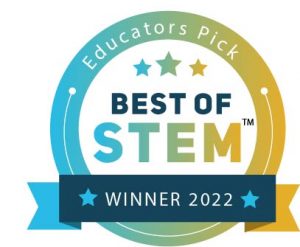The True Story of the Three Little Pigs (Grades K-2)
In this design challenge, students will receive a problem from the story The True Story of the Three Little Pigs by Jon Scieszka. In the story, the wolf tells his side of the story of the The Three Little Pigs. The wolf was planning to bake a birthday cake for his grandma and needed to get a cup of sugar. However, on his journey he sneezes and blows down the homes of the three little pigs. The students will be presented with the following problem, “The eldest brother of the three little pigs is looking to rebuild the destroyed homes in his community after the sneezing wind disaster caused by the wolf.” Students will put on their engineering hats to help the eldest brother rebuild homes in the community. Students will engage in a STEM challenge to build a home in 25 minutes that can withstand the wolf’s sneeze for 5 seconds. Teams will receive bonus points if their home can withstand the wolf’s super sneeze for 5 seconds while protecting the pig inside.
Jack & the Beanstalk (Grades K-2)
In this design challenge, students will receive a problem inspired by the story Jack and the Beanstalk by Carol Ottolenghi. In the story, Jack climbs a magical beanstalk where he finds a castle that he steals several items from before returning home. The students will be presented with the following problem: “Jack wants to go back to the castle in the sky to return the hen and the harp he stole, but he is out of magic beans. He does not know how he will get back to the castle. Today, you are going to put on your engineering hat to help Jack build a “beanstalk” that can reach all the way to the giant’s castle in the sky so he can return the stolen items.” Students will engage in a STEM challenge to build the tallest structure in 25 minutes that can hold a toy figure (Jack) for one minute. Teams will receive bonus points if their structure can withstand a 30-second windstorm before Jack safely returns to his home on the ground.
Floating Zoo (Grades K-2)
In this design challenge, students will receive a problem from the story Who Sank the Boat? by Pamela Allen. Beside the sea, there once lived a cow, a donkey, a sheep, a pig, and a tiny little mouse. They were good friends, and one warm, sunny morning, they decided to go for a row in the bay. Students will put on their engineering hats to build a boat that can hold a cow, donkey, sheep, pig, and mouse without sinking. Students will engage in a STEM challenge to build a boat in 25 minutes that can float while holding the animal figures for a set amount of time without sinking. Teams will receive bonus points if their boat can hold a horse in addition to all the other animals for an additional 10 seconds.
Coast to Coast: Maintaining Healthy Habits (Grades 3-5)
In this design challenge, students will discuss ecosystems and take part in a species survival demonstration. This demonstration will challenge students to remove as many species from the environment as possible within one minute and discuss their results. The students will then be presented with the following problem: “Our ecosystem’s population balance has gone out of control. We need to fix our ecosystem to make sure there is equilibrium amongst the species.” The students will put on their engineering hats to assist in maintaining species populations within an ecosystem. The teams will have an opportunity to design a tool to remove the invasive species and restore balance to the ecosystem.
Forces in Action: Crane Design (Grades 6-8)
In this design challenge, students will be tasked with developing a crane used for loading and unloading payloads from vessels at a port. They will explore the relationship between force and motion by applying the engineering design process and Newton’s Three Laws of Motion. Students will be presented with the following scenario: “A port’s crane has broken down! This broken dockside crane is essential for loading and unloading payloads from vessels. Today, you will take on the role of engineer to create an initial design for a new crane.”
Acoustic Shields (Grades 9-12)
In this design challenge, students will innovate the design of a bubble curtain for the Port of LU, which will be able to reduce underwater construction noises as the port builds its new dock. Students will learn about Avogadro’s, Boyle’s, and Charles’ gas laws and how these laws are used by engineers in real-world applications. The students will be presented with the following problem: “The Port of LU wants to invest in a bubble curtain to help reduce underwater noise while constructing a new dock. They are very concerned with reducing their environmental impact while keeping their tight construction timeline. The Port of LU needs an engineering team that can design and manufacture one before construction begins.” Students will engage in a STEM challenge to design an innovative bubble curtain and pitch that idea to their classmates (or a panel) to win the bid for the job with the Port of LU. Teams will be challenged to keep the cost low and consider other environmental mitigations for bonus points.


 Chemical and Physical Changes (Grades 4-8)
Chemical and Physical Changes (Grades 4-8)